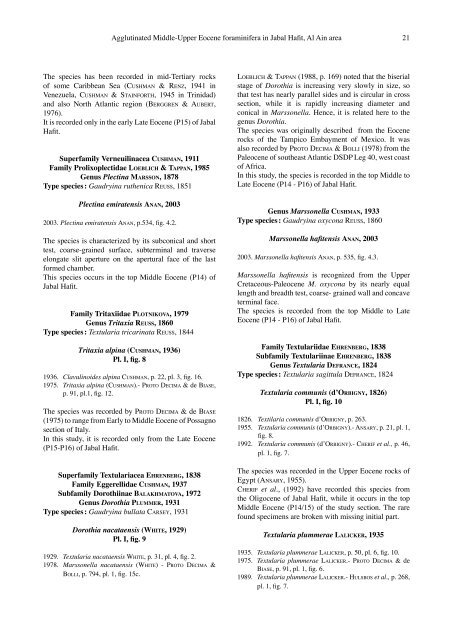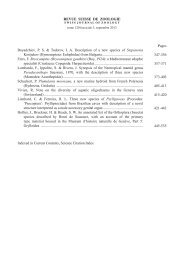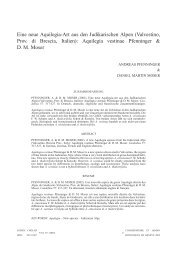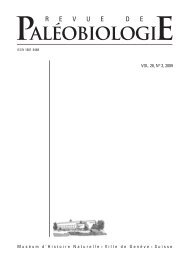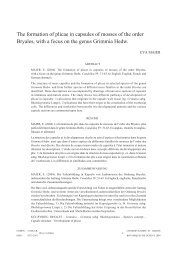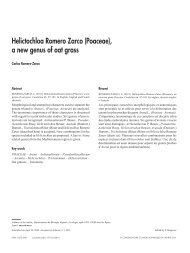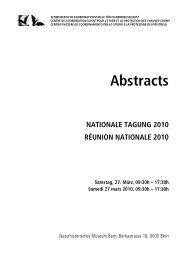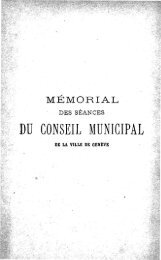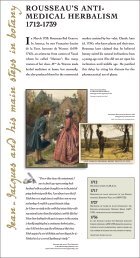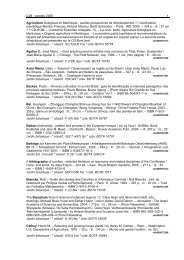Agglutinated Middle-Upper Eocene foraminifera in Jabal Hafit, Al ...
Agglutinated Middle-Upper Eocene foraminifera in Jabal Hafit, Al ...
Agglutinated Middle-Upper Eocene foraminifera in Jabal Hafit, Al ...
Create successful ePaper yourself
Turn your PDF publications into a flip-book with our unique Google optimized e-Paper software.
<strong>Agglut<strong>in</strong>ated</strong> <strong>Middle</strong>-<strong>Upper</strong> <strong>Eocene</strong> <strong>foram<strong>in</strong>ifera</strong> <strong>in</strong> <strong>Jabal</strong> <strong>Hafit</strong>, <strong>Al</strong> A<strong>in</strong> area 21<br />
The species has been recorded <strong>in</strong> mid-Tertiary rocks<br />
of some Caribbean Sea (CUSHMAN & RENZ, 1941 <strong>in</strong><br />
Venezuela, CUSHMAN & STAINFORTH, 1945 <strong>in</strong> Tr<strong>in</strong>idad)<br />
and also North Atlantic region (BERGGREN & AUBERT,<br />
1976).<br />
It is recorded only <strong>in</strong> the early Late <strong>Eocene</strong> (P15) of <strong>Jabal</strong><br />
<strong>Hafit</strong>.<br />
Superfamily Verneuil<strong>in</strong>acea CUSHMAN, 1911<br />
Family Prolixoplectidae LOEBLICH & TAPPAN, 1985<br />
Genus Plect<strong>in</strong>a MARSSON, 1878<br />
Type species : Gaudry<strong>in</strong>a ruthenica REUSS, 1851<br />
Plect<strong>in</strong>a emiratensis ANAN, 2003<br />
2003. Plect<strong>in</strong>a emiratensis ANAN, p.534, fig. 4.2.<br />
The species is characterized by its subconical and short<br />
test, coarse-gra<strong>in</strong>ed surface, subterm<strong>in</strong>al and traverse<br />
elongate slit aperture on the apertural face of the last<br />
formed chamber.<br />
This species occurs <strong>in</strong> the top <strong>Middle</strong> <strong>Eocene</strong> (P14) of<br />
<strong>Jabal</strong> <strong>Hafit</strong>.<br />
Family Tritaxiidae PLOTNIKOVA, 1979<br />
Genus Tritaxia REUSS, 1860<br />
Type species : Textularia tricar<strong>in</strong>ata REUSS, 1844<br />
Tritaxia alp<strong>in</strong>a (CUSHMAN, 1936)<br />
Pl. I, fig. 8<br />
1936. Clavul<strong>in</strong>oides alp<strong>in</strong>a CUSHMAN, p. 22, pl. 3, fig. 16.<br />
1975. Tritaxia alp<strong>in</strong>a (CUSHMAN).- PROTO DECIMA & de BIASE,<br />
p. 91, pl.1, fig. 12.<br />
The species was recorded by PROTO DECIMA & de BIASE<br />
(1975) to range from Early to <strong>Middle</strong> <strong>Eocene</strong> of Possagno<br />
section of Italy.<br />
In this study, it is recorded only from the Late <strong>Eocene</strong><br />
(P15-P16) of <strong>Jabal</strong> <strong>Hafit</strong>.<br />
Superfamily Textulariacea EHRENBERG, 1838<br />
Family Eggerellidae CUSHMAN, 1937<br />
Subfamily Dorothi<strong>in</strong>ae BALAKHMATOVA, 1972<br />
Genus Dorothia PLUMMER, 1931<br />
Type species : Gaudry<strong>in</strong>a bullata CARSEY, 1931<br />
Dorothia nacataensis (WHITE, 1929)<br />
Pl. I, fig. 9<br />
1929. Textularia nacataensis WHITE, p. 31, pl. 4, fig. 2.<br />
1978. Marssonella nacataensis (WHITE) - PROTO DECIMA &<br />
BOLLI, p. 794, pl. 1, fig. 15c.<br />
LOEBLICH & TAPPAN (1988, p. 169) noted that the biserial<br />
stage of Dorothia is <strong>in</strong>creas<strong>in</strong>g very slowly <strong>in</strong> size, so<br />
that test has nearly parallel sides and is circular <strong>in</strong> cross<br />
section, while it is rapidly <strong>in</strong>creas<strong>in</strong>g diameter and<br />
conical <strong>in</strong> Marssonella. Hence, it is related here to the<br />
genus Dorothia.<br />
The species was orig<strong>in</strong>ally described from the <strong>Eocene</strong><br />
rocks of the Tampico Embayment of Mexico. It was<br />
also recorded by PROTO DECIMA & BOLLI (1978) from the<br />
Paleocene of southeast Atlantic DSDP Leg 40, west coast<br />
of Africa.<br />
In this study, the species is recorded <strong>in</strong> the top <strong>Middle</strong> to<br />
Late <strong>Eocene</strong> (P14 - P16) of <strong>Jabal</strong> <strong>Hafit</strong>.<br />
Genus Marssonella CUSHMAN, 1933<br />
Type species : Gaudry<strong>in</strong>a oxycona REUSS, 1860<br />
Marssonella hafitensis ANAN, 2003<br />
2003. Marssonella hafitensis ANAN, p. 535, fig. 4.3.<br />
Marssonella hafitensis is recognized from the <strong>Upper</strong><br />
Cretaceous-Paleocene M. oxycona by its nearly equal<br />
length and breadth test, coarse- gra<strong>in</strong>ed wall and concave<br />
term<strong>in</strong>al face.<br />
The species is recorded from the top <strong>Middle</strong> to Late<br />
<strong>Eocene</strong> (P14 - P16) of <strong>Jabal</strong> <strong>Hafit</strong>.<br />
Family Textulariidae EHRENBERG, 1838<br />
Subfamily Textulari<strong>in</strong>ae EHRENBERG, 1838<br />
Genus Textularia DEFRANCE, 1824<br />
Type species : Textularia sagittula DEFRANCE, 1824<br />
Textularia communis (dʼORBIGNY, 1826)<br />
Pl. I, fig. 10<br />
1826. Textilaria communis dʼORBIGNY, p. 263.<br />
1955. Textularia communis (dʼORBIGNY).- ANSARY, p. 21, pl. 1,<br />
fig. 8.<br />
1992. Textularia communis (dʼORBIGNY).- CHERIF et al., p. 46,<br />
pl. 1, fig. 7.<br />
The species was recorded <strong>in</strong> the <strong>Upper</strong> <strong>Eocene</strong> rocks of<br />
Egypt (ANSARY, 1955).<br />
CHERIF et al., (1992) have recorded this species from<br />
the Oligocene of <strong>Jabal</strong> <strong>Hafit</strong>, while it occurs <strong>in</strong> the top<br />
<strong>Middle</strong> <strong>Eocene</strong> (P14/15) of the study section. The rare<br />
found specimens are broken with miss<strong>in</strong>g <strong>in</strong>itial part.<br />
Textularia plummerae LALICKER, 1935<br />
1935. Textularia plummerae LALICKER, p. 50, pl. 6, fig. 10.<br />
1975. Textularia plummerae LALICKER.- PROTO DECIMA & de<br />
BIASE, p. 91, pl. 1, fig. 6.<br />
1989. Textularia plummerae LALICKER.- HULSBOS et al., p. 268,<br />
pl. 1, fig. 7.


